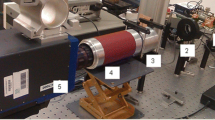Abstract
A SIMPLE thermal image-converter can be made, using the dependence upon temperature of the absorption threshold in a semiconductor. When a sample of a suitable material is viewed by transmitted monochromatic light at a wave-length near the threshold, any variations in temperature appear as differences in the transmitted intensity. If a scene in which there are objects of various temperatures and emissivities is focused on the semiconductor, a visible picture will result.
Similar content being viewed by others
References
Sayce, E., Proc. Roy. Soc. N.S.W., 51, 356 (1917). Northrop, D. C., S.E.R.L. Quart. Rep. No. 31 (July 1953).
Hilsum, C., Proc. Phys. Soc., B, 59, 506 (1956).
Hilsum, C., J. Opt. Soc. Amer., 44, 188 (1954); 45, 135 (1955).
Frank, K., and Stow, R. L., Rev. Sci. Instr., 25, 514 (1954).
Author information
Authors and Affiliations
Rights and permissions
About this article
Cite this article
HARDING, W., HILSUM, C. & NORTHROP, D. A New Thermal Image-Converter. Nature 181, 691–692 (1958). https://doi.org/10.1038/181691a0
Published:
Issue Date:
DOI: https://doi.org/10.1038/181691a0
- Springer Nature Limited
This article is cited by
-
Spatial resolution of the thermal method of recording and visualizing an electromagnetic field on film structures
Radiophysics and Quantum Electronics (1970)
-
An investigation of the diffraction fields of plane inhomogeneities in a waveguide by means of metal-semiconductor film structures
Radiophysics and Quantum Electronics (1970)





